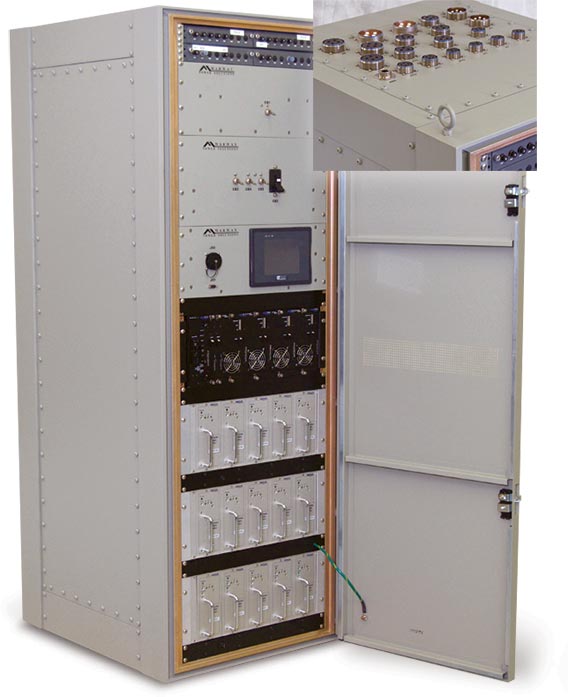Shipboard Power Distribution Units
AMDR
Missile Defense Radar
Marway supported this design program for several years as changes evolved during AMDR development. Includes a number of custom control features to support connected computing equipment. Testing and analysis to several 810 and EMC standards.
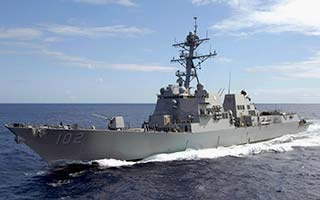
RAMSES
Defensive Jamming
This unit distributes and monitors power in multiple power forms for a variety of application and computing equipment. Power data is communicated over Ethernet. Designed and tested to various sections of 810, 167, 1399, and MIL-HDBK-217 standards.
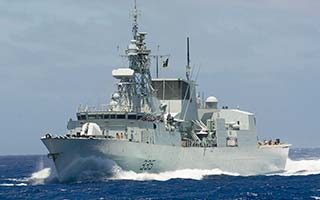
CSRR
Radio Communications
Installed on multiple submarine classes for the standardization of radio communications. This unit delivers power to numerous radio room communication equipment in a very compact package while meeting shock and vibration requirements.
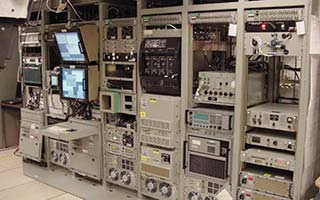
Metal Shark Boat
Cabin Power Distribution
This patrol boat uses Marway’s PDU to replace conventional panels for radio, navigation, lighting and more for faster, cleaner installation. Additionally, our ability to manage custom versions allows MSB to tailor solutions for their customers.
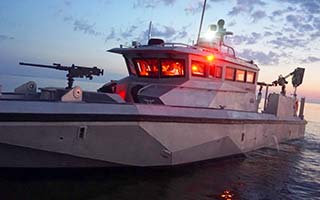
VPM
Virginia Payload Module
Supporting submarine weapons systems, this PDU consolidates conversion, conditioning, auto transfer, and distribution from sprawled out panels. Integrated test points and blind-mate connectors further simplified installation and support.
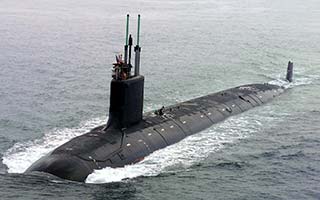
FMC
Power Monitoring and Transfer
This full-rack-sized PDU includes a number of high capacity auto transfer systems to switch to battery power sources. Touchscreen monitoring is integrated to the ship’s controls over Ethernet. Built to to meet 901 shock test standards.
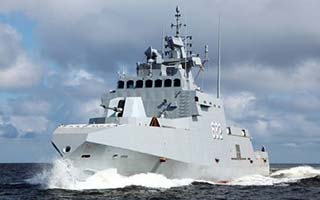
Meeting Shipboard Power Challenges
Marway’s shipboard PDUs are being used to distribute power to communications, navigation, radar, countermeasures, and weapons systems.
A consideration for deployed power distribution applications is the environment the PDU will be used in. Military applications, of course, conjures images of the battle space ruggedness. In small boats, PDUs can be exposed to extreme weather. In larger vessels, PDUs can be isolated from the extremes of harsh environments.
In all environments, there can be the need to condition prime power to deliver clean, stable power to mission critical electronics. There are a lot of unique control and connectivity needs depending on the application as well.
Marway has been creating application-specific PDUs for decades, and has been meeting the needs for specialized shipboard PDUs for many years.
What to look for in a shipboard PDU ↑
- Protects downstream equipment from noisy prime power using EMI filters, surge suppressors, and other techniques.
- Saves space by integrating conditioning and conversion needs instead of housing them as external boxes.
- Improves integration by providing the exact connectivity and controls needed for site-specific equipment.
- Complies with general and military-specific standards for electrical power handling equipment.
- Meets harsh environmental needs.
What to look for in a PDU supplier ↑
- Takes the time to understand the application, explore needs, and consider design options.
- Optimizes the selection of application-specific components for capacity matching, packaging efficiency, and cost.
- Designs and manufactures enclosures to meet unique needs for installation, cable routing, and other integration details.
- Manages the entire process of standards testing and certification, when required, prior to delivery.
- Understands shipboard platforms and applications, and can apply specific military standards to PDU design.
Applications, Platforms, and Programs ↑
- Supporting communications, intelligence, weapons controls, development, simulation, test, diagnostic systems, and more.
- Naval surface vessels, submarines, pilot boats, and others.
- AMDR, RAMSES, CSRR, VPM, and other programs.
Compliance and Standards ↑
- Certified AS9100 with ISO 9001.
- TAA, ITAR, and NIST compliant.
- MIL-STDs 461, 810, 901, 167, 1399, and others.
- Environment and reliability testing/certification when required.
- UL and CE certification (others when required).
Custom, COTS, COTS-Modified ↑
- Marway specializes in application-specific PDUs.
- Rackmount chassis from 0U to 24U, to rack sized.
- Custom enclosures for non-rack applications.
- AC, DC — up to 600 volts, 400 amps.
- We have nearly 300 standard basic and smart PDUs.
- 1-phase, 3-phase, 15-, 20-, and 30-amp models.
- 1U, 2U, 3U, and vertical 0U configurations.
Conversion, Conditioning, and Control ↑
- Meet EMI standards using filters, isolation, shielding.
- Mitigate voltage spikes/transients using surge suppression.
- Integration and conversion of power forms in single enclosure.
- Local and remote power monitoring and switching.
- EPO and interlock integration and remote panels.
Networked and Non-networked ↑
- Non-networked PDUs still offer some remote switching through discrete signals from remote panels.
- Networked PDUs offer remote control and monitoring over Ethernet using HTTP/S, SSH, Telnet, and SNMP.
- Scripted automation through Telnet, SSH, SNMP, or RESTful API over HTTP/S.
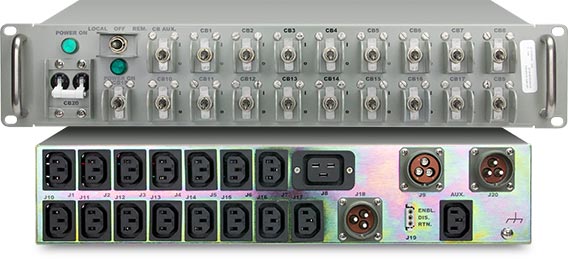
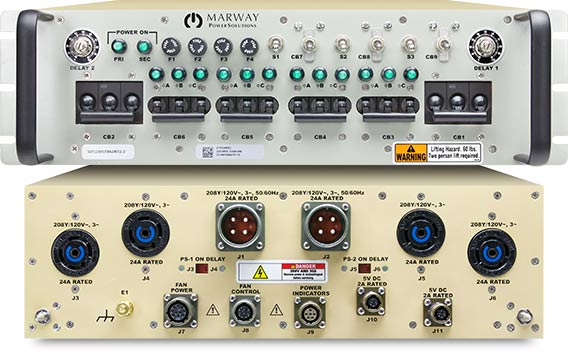
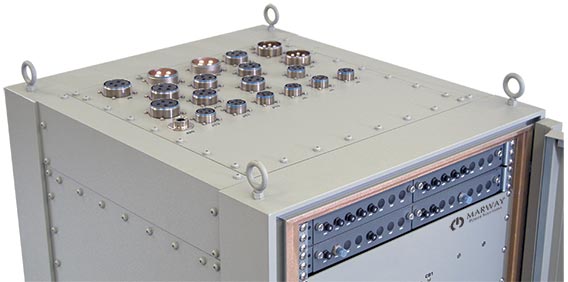
Battling Noisy Power ↑
Noisy source power signals occur in shipboard environments due to the varying loads of nearby high-powered equipment. Similar to how sudden water pressure surges cause pipes to rattle, sudden surges of “pressure” and “flow” (voltage and current) in electrical lines cause disturbances in power signals. Where a weak fitting along a pipe might leak, a vulnerable component in an electronic system may fail.
Most COTS PDUs are designed for office-like or data-center environments where there is little influence on power signals from nearby equipment. At most, these PDUs may have some surge protection, since those devices are relatively low cost and small.
Shipboard PDUs will typically need to integrate surge suppression, EMI filters, isolation transformers, and other tools to mitigate the severity of noisy power signals caused from many different sources. This can be especially true for electrically isolated environments like ships and boats where significant equipment exists on the same power subsystem. Selecting these components requires an understanding of the types of noise which are expected in the environment, and matching various attributes of the components to the power form being conditioned.
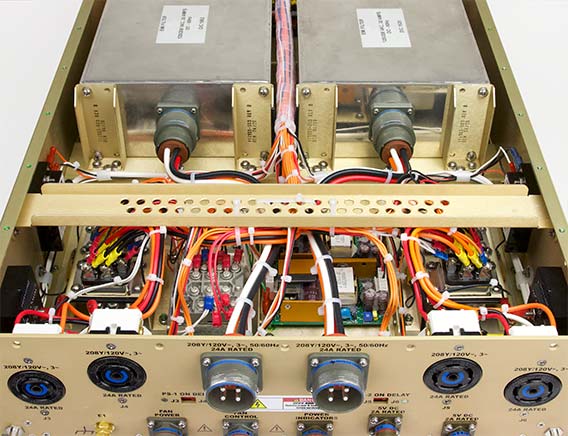
Integrating Needed Power Forms ↑
Ships and even moderate size boats need a mixture of different power forms to serve the variety of onboard equipment. A power form is the combination of specifications for voltage type, voltage rating, and current rating. For example, 208 Vac, 15 amps vs. 80 Vdc 60 amps are two different power forms.
A ship’s primary power source will be transformed into a couple of different forms for broad shipboard distribution. In larger vessels, this is typically three-phase ac power for some areas in addition to common 120 volt outlets. In shipboard applications, where there’s a diverse range of equipment, there may be a need for more types of power. Ac may be needed in multiple three-phase and single-phase forms. Different voltages may be needed to serve the larger and smaller pieces of equipment. Even dc power is often needed in various voltages in the same work spaces as ac power.
The PDU which will already be needed for distribution, is a convenient and efficient place to integrate transformers, power supplies, and power converters to create multiple power forms from a single facility or generated source. This can simplify installation, and provide better control options compared to having multiple power services wired throughout a facility.
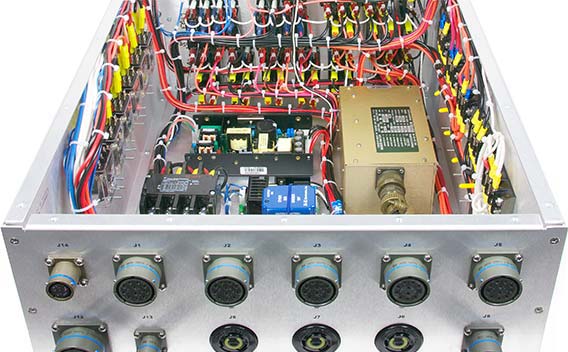
Meeting Unique Control and Connection Needs ↑
Shipboard PDUs often require a wider range of circuit designs, control features, power monitoring, and even remote management capabilities. Most commodity power distribution products have a single circuit serving all outlets with perhaps an on/off switch or breaker. Shipboard environments often require more control over multiple individual circuits. Adapting to unique switching, display, and control needs, is a key need in a shipboard PDU.
Another area of important flexibility for a shipboard PDU is cable connectors. Most PDUs are designed for only common commodity receptacles. In the shipboard realm, there are numerous specialized connectors. While there are standardized ac power connectors, even they come in dozens of types depending on voltage, current, safety features like locking, resistance to water, vibration, and more. Even more than power connectors, control signal connectors are even more varied. Integration to external interlocks, sensors, and more require that a PDU have the flexibility to incorporate what a facility needs.
While deployed PDUs may require customization, standardized industrial PDUs may work for test and development applications, like Marway’s 5 and 8 Series. These can also serve as a foundation for a COTS-modified approach for test, simulation, and diagnostic equipment PDUs.
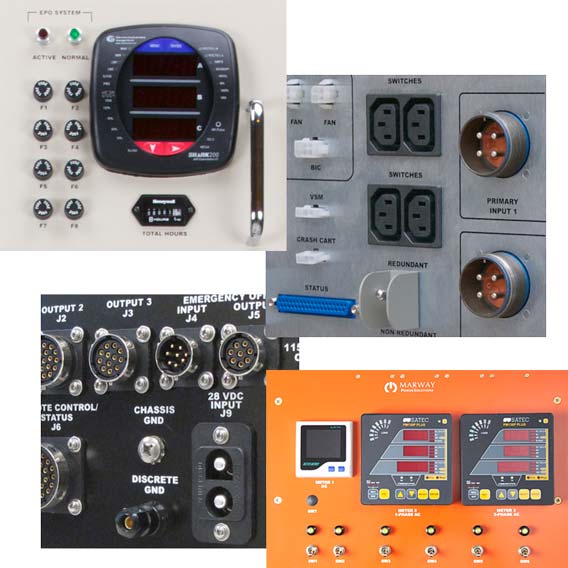
Handling Harsh Environments ↑
A consideration for deployed power distribution applications is the environment the PDU will be used in. Military applications, of course, conjures images of the battle space ruggedness. In small boats, PDUs can be exposed to extreme weather. In larger vessels, PDUs can be isolated from the extremes of harsh environments. Marway can tailor a PDU to these distinct shipboard environments.
Vibration and shock may be a key consideration. PDUs may be subject to vibrations and jarrings from nearby heavy equipment or weapons systems. Meeting the requirements of MIL-STDs 901 and 167 is a critical capability in these applications.
Enclosures, connectors, and controls may need to handle wide operating temperatures, or extremes of weather in smaller boats. To handle cold environments, specialized components, or even internal heating, may be necessary. Depending on the use of electronic controls in the PDU, cooling by convection venting or fans may also be an issue for very warm environments.
Since most pre-designed, standard PDUs are going to be designed for general purpose applications, they’re not likely to meet many harsh environment needs. Most harsh environment applications tend to be unique in their power needs anyway, so custom designs are often used. Marway specializes in custom PDU applications, and is experienced with a number of the skills and standards used to handle harsh environments.
